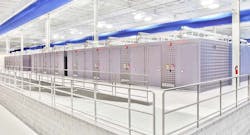Which Matters More in a Colocation Provider: Capacity or Efficiency?
In this week’s Voices of The Industry, David Mettler, vice president of sales and market director for the United States, IO Data Centers, explores how finding the right colocation provider can help you improve efficiency in the data center.
David Mettler, vice president of sales and market director for the United States, IO Data Centers
I recently saw an online ad that boasted $400 per month for a cabinet, power, and 1 Gbps Internet bandwidth. On its face, it seemed like a great deal. But will it ultimately provide the cost and energy efficiency you really need? What if more capacity is needed…or less?
And yet this is how colocation services are often procured. Enterprises will go to market with a generic set of requirements—for example, 10,000 square feet and 1 MW of power. They’ll get baseline pricing and service terms from multiple data center providers, do an apples-to-apples comparison, and typically choose the lowest cost provider.
While this traditional method makes it easier to procure colocation services, under-designing by overbuying doesn’t maximize utilization. These organizations may end up with the lowest cost provider, but they often utilize just 60 percent of capacity—or less. They’ve purchased capacity over efficiency.
Corporate data centers are often guilty of under- or over-buying capacity. When applications start having performance issues, inevitably the knee-jerk IT reaction is to throw more hardware at them, driving capital expenditures up—often needlessly—and frustrating the facilities teams who must figure out how to efficiently power and cool additional equipment purchases.
As a result, these organizations have built out their on-premises data centers over the years, making it much harder to let those legacy designs go—even if their IT teams lack confidence in them. It also makes it much easier to continue to deploy legacy infrastructures in a traditional way rather than an efficient way. Or to choose over-provisioning instead of right-sizing.
The temptation then is to seek out a colocation provider who promises bargain-basement space and power—which is simply over-provisioning on a macro level.
So how do you turn the “capacity over efficiency” equation around? By aligning utilization with capacity.
[clickToTweet tweet=”David Mettler – How do you turn the “capacity over efficiency” equation around? #datacenters” quote=”David Mettler – How do you turn the “capacity over efficiency” equation around? #datacenters”]
This, of course, is easier said than done. It’s not enough to understand which applications are needed to support your organization and what IT assets are supporting those applications, though that’s a start.
Dive into what your real requirements are so you can capitalize on a solution that maximizes utilization and provides a better operating agreement so you’re paying for exactly what you need.
The challenge is to go to the lowest common denominator to accommodate demand. How much hardware do you really need to meet application needs? Then figure out how to maximize capacity by shifting workloads around to meet performance and user demands with the equipment you have—without disrupting operations.
In other words, design for tomorrow—or the long term—instead of designing for today.
For example, it requires very little thought to procure another piece of IT equipment. You just have to spend the money. Alternately, you can spend a little time figuring out how to accommodate a large piece of existing equipment with a low power draw in a high density environment. Which approach is more efficient?
Spending the time to thoroughly assess your environment—with all the relevant stakeholders—and understanding how much capacity is needed to reliably meet demand is only a first step.
The next step is to find a colocation provider who doesn’t lull you into a “price per square foot” conversation. This data-center-as-real-estate approach means that those providers are more than happy to move your behemoth legacy infrastructure into the largest space possible and plug you in.
Your colocation provider should approach the data center as a service. They should understand how to maximize their resources for the greatest power and cooling efficiency and be expert in sustainable data center operations.
Colocation providers that build communities and partnerships around a shared interest in building and supporting sustainable data centers helps them negotiate more favorable pricing on energy, connectivity, and infrastructure hardware.
In addition, since data centers inherently use a lot of power, most organizations already have energy efficiency goals in place—or they will soon. Having a colocation partner who understands the value of energy efficiency can ultimately benefit its customers.
Your colocation provider should also understand how high density IT deployments help to maximize utilization and increase efficiency—not only for the provider itself but for its customers. High density colocation modules offer a larger IT imprint within a smaller footprint.
Spend the time to design for the long term, and you’ll start realizing huge efficiency benefits today.
David Mettler is vice president of sales and market director for the United States at IO Data Centers.


